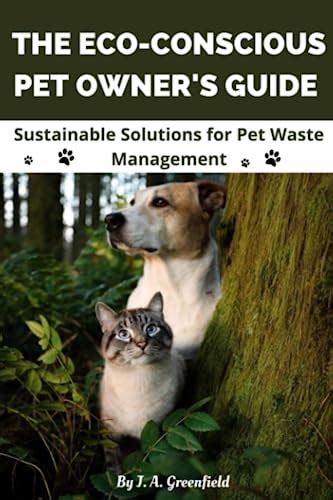As conscious pet owners, we have a responsibility to minimize our furry friends’ environmental impact. By embracing eco-friendly practices, we can foster a healthier planet for both our pets and future generations. Here’s a comprehensive guide to help you become an environmentally responsible pet owner by 2025:

1. Sustainable Pet Food Choices
- Opt for eco-friendly pet food brands that use sustainable ingredients, reduce packaging waste, and support ethical farming practices.
- Consider plant-based pet food as a more environmentally friendly alternative to traditional meat-based diets.
2. Responsible Waste Management
- Dispose of pet waste properly by using biodegradable bags and composting or flushing it.
- Use environmentally friendly litter made from sustainable materials like recycled paper or pine pellets.
3. Energy-Efficient Pet Care
- Unplug pet appliances when not in use, such as heated beds, water fountains, and air purifiers.
- Consider using solar-powered pet products like automatic feeders or water dispensers.
4. Eco-Conscious Pet Travel
- Choose eco-friendly transportation options like walking, biking, or using public transport to get your pets to appointments or outings.
- Look for pet-friendly hotels and accommodations that prioritize sustainability.
5. Water Conservation
- Monitor your pet’s water consumption and refill their bowl only when necessary.
- Use a water-saving showerhead while bathing your pet or consider using a waterless pet shampoo.
6. Responsible Pet Toys
- Choose pet toys made from recycled materials or sustainable sources like wood or bamboo.
- Avoid disposable pet toys that end up in landfills and opt for durable, long-lasting options.
7. Pet Grooming with Care
- Use eco-friendly pet shampoos and conditioners that are biodegradable and free from harsh chemicals.
- Consider using natural grooming tools like bamboo brushes and grooming gloves.
8. Ethical Pet Breeding
- Adopt pets from shelters or rescue organizations instead of buying from breeders.
- Spay or neuter your pets to prevent overpopulation and reduce environmental impact.
9. Pet-Friendly Landscaping
- Create a pet-friendly yard using native plants that require less water and maintenance.
- Avoid using pesticides and herbicides harmful to pets and the environment.
10. Pet Healthcare and Waste Reduction
- Use reusable towels instead of disposable paper towels for pet accidents.
- Recycle pet medication containers and dispose of unused medications properly.
11. Pet Products and Sustainability
- Buy pet supplies from sustainable sources that prioritize eco-friendly packaging and materials.
- Consider purchasing second-hand pet products to reduce waste and save money.
12. Educating Others
- Share your knowledge about environmentally responsible pet ownership with friends, family, and neighbors.
- Support organizations working to promote pet adoption, reduce animal waste, and create a greener future for pets.
Case Study: Sarah and Max’s Eco-Journey
Sarah and Max are dedicated pet owners who have embraced eco-friendly practices. By making small changes, they have significantly reduced their pets’ environmental impact.
- Sustainable Pet Food: They switched to a plant-based pet food made from organic ingredients and biodegradable packaging.
- Responsible Waste Management: They use compostable poop bags and biodegradable cat litter made from recycled paper.
- Energy-Efficient Pet Care: They installed a solar-powered pet water fountain and unplug their heated pet bed when not in use.
By adopting these eco-friendly practices, Sarah and Max have not only reduced their pets’ environmental footprint but also inspired others to do the same.
Comparison: Eco-Friendly vs. Traditional Pet Ownership
| Feature | Eco-Friendly Pet Ownership | Traditional Pet Ownership |
|---|---|---|
| Pet Food | Plant-based or sustainable ingredients | Meat-based diets |
| Waste Management | Biodegradable bags, compostable litter | Plastic bags, non-biodegradable litter |
| Energy Consumption | Energy-efficient appliances, solar power | Conventional appliances |
| Pet Products | Recycled materials, sustainable sources | Non-recyclable, conventional materials |
| Healthcare and Waste | Reusable towels, responsible medication disposal | Disposable paper towels, improper medication disposal |
Pain Points and Motivations
Pain Points:
- Lack of awareness about eco-friendly pet care options
- Limited availability of sustainable pet products
- Additional cost associated with eco-friendly practices
Motivations:
- Concern for the environment and future generations
- Desire to provide the best possible care for pets
- Alignment with personal values of sustainability
Common Mistakes to Avoid
- Using single-use pet products: These products generate excessive waste and harm the environment.
- Overfeeding pets: This can lead to obesity and health problems, contributing to pet waste and environmental impact.
- Ignoring responsible waste disposal: Pet waste can contaminate water sources and harm wildlife.
Frequently Asked Questions (FAQs)
1. Is plant-based pet food as nutritious as traditional pet food?
Yes, plant-based pet foods are formulated to meet the nutritional needs of cats and dogs and can provide all the essential nutrients.
2. What are the benefits of using biodegradable pet waste bags?
Biodegradable pet waste bags break down naturally, reducing plastic pollution and protecting wildlife.
3. How can I reduce my pet’s energy consumption?
Unplug pet appliances when not in use, use energy-efficient lighting, and consider solar-powered pet products.
4. What pet products should I avoid for environmental reasons?
Avoid disposable pet toys, non-recyclable pet food packaging, and plastic pet bowls.
5. How can I encourage others to adopt eco-friendly pet care practices?
Share your experiences and knowledge, support organizations promoting pet adoption, and create pet-friendly communities.
6. Are there any government incentives for eco-friendly pet ownership?
Some municipalities offer tax breaks or incentives for pet owners who use sustainable pet care practices.
Conclusion
By implementing these eco-conscious pet ownership practices, we can create a healthier and more sustainable future for our furry companions and the planet we share. Let’s all strive to become responsible pet owners who care not only for our pets but also for the environment.





















